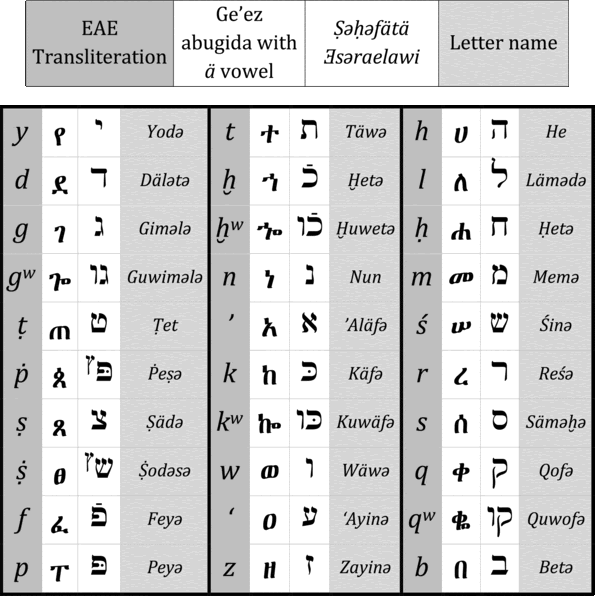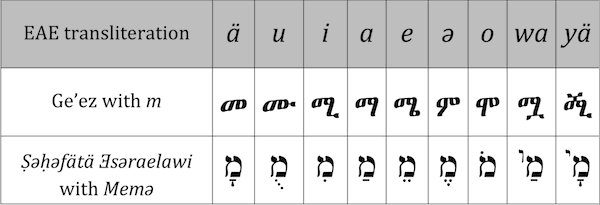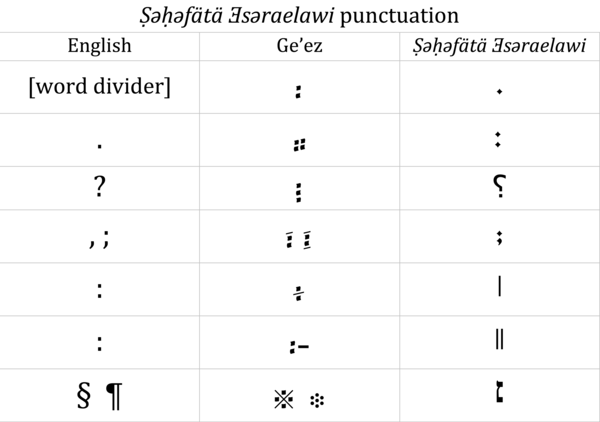Ṣəḥəfätä Ǝsəraelawi is an adaptation of the Hebrew abjad for the Ethiopian Ge’ez language devised by Isaac Mayer. The Betä Ǝsəraelə community of Ethiopia had much of its culture destroyed during the period of the Gondar Empire, and all of the community’s Hebrew texts were destroyed, forcing them to use the Ge’ez biblical texts and the Ethiopic (Ge’ez) script. In many parts of the world Jews adapted the Hebrew alphabet for their own languages, but in Ethiopia the Hebrew alphabet was suppressed. The Ṣəḥəfätä Ǝsəraelawi system is meant to right that historical wrong.
The name of the script, צֶחֶפָֿתָ אֶסֶרַאֵלַוׅ (ጽሕፈተ እስራኤሳዊ / Ṣəḥəfätä Ǝsəraelawi), means "Writing of the Israelites".
The Ethiopic (Ge’ez) script is an abugida, where each letter is modified to determine the vowel. The Hebrew script is an abjad, where the vowels are optional diacritics to the consonants. This is easily rectifiable by making the diacritics mandatory, creating an abugida from an abjad. It is thought that that was how the Ethiopic (Ge’ez) script itself was created.
Not as easily rectifiable is the fact that Ge’ez has certain sounds without a parallel in Hebrew. Some of these voids were filled through historical research (the Hebrew ט and צ were equivalent to the emphathic ṭ and ṣ of Ge’ez, and the Hebrew ו was originally a w sound). But others required new combinations to be created.
Many languages’ diacritics originate from miniscule regular letters (see the fascinating history of the Spanish ñ). So to replace the emphathic ṗ and ṩ of Ge’ez, the Ṣəḥəfätä Ǝsəraelawi system used a superscript ץ, an altered form of צ that the system discards along with other final forms. To represent labialization, a regular ו was added after the consonant. These new combinations are treated as individual letters in the alphabetical system.
Since Ge’ez is an abugida there are hundreds of distinct grapheme forms. The Ṣəḥəfätä Ǝsəraelawi system doesn’t have that many distinct forms, because the vowel marks don’t affect the shape of the basic Hebrew letter. So the majority of consonant names remain the same as regular Hebrew letter names. But the new letters have their own names.
An IPA chart is unfortunately not possible, since Ge’ez is a solely liturgical language and thus has widely varying pronunciations. Instead, the attached alphabet charts use the EAE transcription system for Ethiopian languages, found here. The Ṣəḥəfätä Ǝsəraelawi system uses Hebrew letters and names, but they are in the Ethiopian abugida order.



תָוָלֶדֻ. כּוֶלֻ .סָבֶאֶ. גֶעֻזַנֶ. וָעֶרֻיַנֶ. בָמַעֶרָגֶ .וָבֶחֶגֶ׃ בֹמֻ. כֶֿלִנַ. וָעָקֶלֶ. וָיֶתֶגֵבָרֻ. אָחָדֻ. מֶסֶלָ. אָהָדֻ. בָמָנֶפָֿסָ. אֶכֿוֶנַ׃
ተወልዱ፡ኵሉ፡ሰብእ፡ግዑዛን፡ወዕሩያን፡በማዕረግ፡ወብሕግ። ቦሙ፡ኅሊና፡ወዐቅል፡ወይትጌበሩ፡አሐዱ፡ምስለ፡አሀዱ፡በመንፈሰ፡እኍና።
All human beings are born free and equal in dignity and rights. They
are endowed with reason and conscience and should act towards one another
in a spirit of brotherhood.
(Article 1 of the Universal Declaration of Human Rights)
Tower of Babel in Ge'ez in Ṣəḥəfätä Ǝsəraelawi
Information about Ge'ez and the Ethiopic script | Numbers | Tower of Babel
Ajalaptlajkuilolistli, Čveneburuli / Judeo-Georgian, Grekoiberieraren Alfabeto Berria, Hágrít Nyelv, Inglith, iŋliʃ fidæl, nā hōʻailona ʻōlelo, Pikchukunap Qillqa, Ṣəḥəfätä Ǝsəraelawi, Tianjinjiao, Yahudi Türkçesi, Yūdu lipi
Constructed scripts for: Ainu | Arabic | Chinese languages | Dutch | English | Hawaiian | Hungarian | Japanese | Korean | Lingala | Malay & Indonesian | Persian | Tagalog / Filipino | Russian | Sanskrit | Spanish | Taino | Turkish | Vietnamese | Welsh | Other natural languages | Colour-based scripts | Tactile scripts | Phonetic/universal scripts | Constructed scripts for constructed languages | Adaptations of existing alphabets | Fictional alphabets | Magical alphabets | A-Z index | How to submit a constructed script
[top]
You can support this site by Buying Me A Coffee, and if you like what you see on this page, you can use the buttons below to share it with people you know.

If you like this site and find it useful, you can support it by making a donation via PayPal or Patreon, or by contributing in other ways. Omniglot is how I make my living.
Note: all links on this site to Amazon.com, Amazon.co.uk
and Amazon.fr
are affiliate links. This means I earn a commission if you click on any of them and buy something. So by clicking on these links you can help to support this site.
[top]